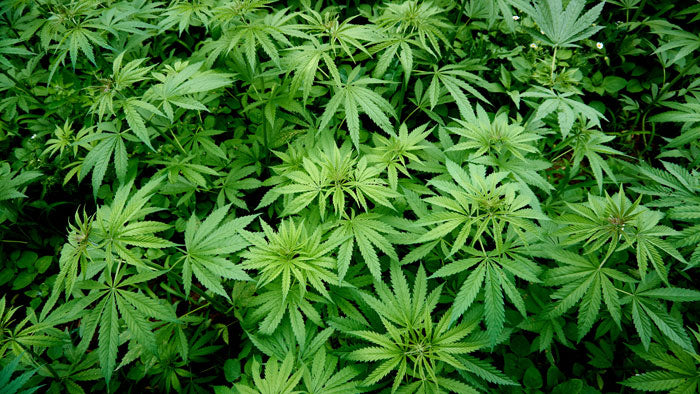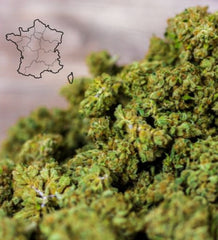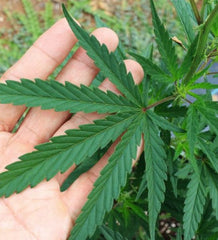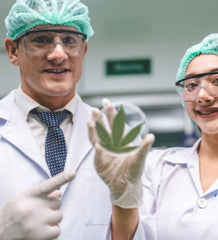
What are the differences between hemp and CBD?
Focus on hemp
Native to Asia, hemp , also known by its Latin name cannabis, is an ancient plant. Cultivated since the Neolithic period, it is one of the first plants domesticated by humans. This green plant with long stems (which can reach up to 5 m in height) is recognizable by its iconic leaf.
Elegant, the hemp leaf is long or wide, with serrated edges. Hemp belongs to the Cannabaceae family and the species Cannabis sativa , which means "cultivated hemp."
There are several varieties, the best known of which are: industrial, textile or agricultural hemp ( Cannabis sativa sativa ) and recreational or Indian hemp ( Cannabis sativa indica ). Although they look similar visually, it is important to distinguish them.
While industrial hemp, as its name suggests, is used in industry (textiles, cosmetics, etc.), Indian hemp is the source of the famous marijuana and hashish.
Focus on CBD
Discovered in the 1940s, CBD is one of the main cannabinoids in hemp, along with THC . Phytocannabinoids are active ingredients naturally present in hemp.
CBD, like THC, is primarily extracted from its flowers and leaves. This hemp molecule is known for its relaxing and anxiolytic properties.
Summary on hemp and CBD
THC, Cannabis, Hemp or CBD: Here's What You Need to Know
Do not confuse:
- Cannabis sativa sativa and Cannabis sativa indica ; Hemp or cannabis is wrongly considered a narcotic, because the term cannabis commonly refers to recreational cannabis to the point of having become a synonym for drugs.
However, as we have seen above, only certain varieties of cannabis such as Cannabis sativa indica have this psychotropic power, due to the high presence of THC.
Indeed, the THC level differs from one variety to another. Thus, unlike Cannabis sativa indica , Cannabis sativa sativa contains a very low THC content.
- CBD and THC. Both CBD and THC come from the flowers and leaves of the hemp plant, which produces them naturally. However, CBD is the non-psychotropic molecule in hemp, known for its calming and relaxing effects.
THC, on the other hand, is a psychoactive substance that causes dizziness, euphoria, and intoxication, as well as psychological dependence. This is why CBD is legal, while THC is prohibited in many countries, such as France.
CBD products

CBD is gaining popularity among consumers, firstly because it is a natural ingredient and secondly because they appreciate its therapeutic properties.
Indeed, several surveys on CBD, carried out in particular in France and England, reveal that CBD consumers use it mainly to reduce stress , anxiety or pain , facilitate sleep and improve its quality, or even to wean themselves off cannabis loaded with THC.
The applications of CBD are therefore varied. Furthermore, CBD comes in different forms (raw flowers or leaves, oils, liquids, etc.). Thus, you will find a multitude of products on the market, mainly:
- food (candies, cakes, infusions, etc.);
- cosmetics (balms, creams, CBD hemp oils , etc.);
- to smoke ( e-liquids , CBD hemp flowers , etc.);
- for animals (oils, treats, lozenges, etc.).
Thanks to its many advantages, hemp's market opportunities are also diverse. Moreover, they have multiplied over time (textiles, food, cosmetics, construction, etc.), because all elements of the plant are usable (from seed to wood, including fiber).
Indeed, the high-protein seed (or hempseed) is used to extract an oil that is used in food and cosmetics. The seed can also be eaten raw, roasted, salted, or sweetened.
Once dried, the stem is transformed into straw, which is then defibrated to separate the wood (called hemp shiv) from the fiber. The wood is then sold as animal bedding or as mulch for gardens.
Finally, because of their strength, the fibers are used to make clothing, cigarette paper and even certain books such as the Bible.
With interesting absorption properties and porosity, they are increasingly associated with materials such as plastic, for the design of lighter car dashboards, or concrete, in order to increase the thermal and acoustic insulation of the home.
A booming European and French market
In Europe, the CBD market has been growing steadily for several years. In France, 2018 saw a boom in physical and virtual stores selling CBD products.
Indeed, according to the SPC (Professional Hemp Union), the thousand mark was reached in 2021 compared to around a hundred in 2018.
This phenomenon is explained by the fact that more and more French people (around 10% of the population) are consuming CBD for well-being purposes, as mentioned previously.
Regulations that listen to the market
In France, regulations have long been prohibitive towards CBD and legal uncertainty persists to this day in the country.
However, thanks to the decision of the CJEU (Court of Justice of the European Union) in November 2020, CBD legislation has nevertheless been relaxed.
This decision ruled that French law conflicted with EU (European Union) law, which authorizes the use and sale of CBD within its borders.
As a result, French authorities do not have the authority to ban the sale of CBD in France. However, despite its legalization in June 2021, this product remains highly regulated and tightly controlled in France.
Here are the CBD products authorized for sale in France in 2022:
- raw leaves and flowers, resins and hemp-derived products with a THC content of less than 0.3%;
- finished products containing CBD with a THC level of 0%.
Hemp cultivation, for its part, has always been legal in France.
France is also the leading producer of hemp in Europe, with nearly 20,000 hectares cultivated. However, hemp production remains strictly regulated.
In France, as in Europe, only varieties with a maximum THC level of 0.3% can be cultivated.
Furthermore, only hemp growers are allowed to grow them and must only exploit certain parts (seeds and fibers).






